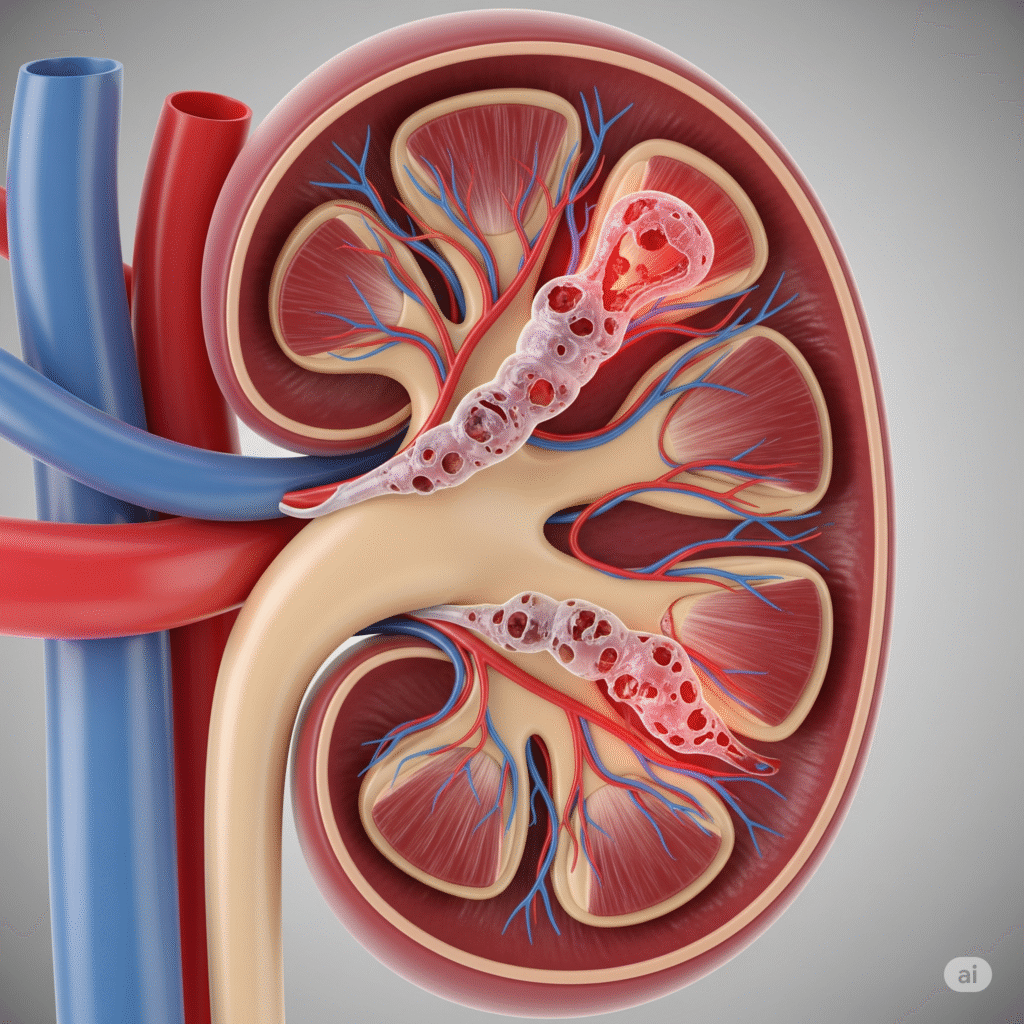Acute kidney injury
Introduction
Acute kidney injury (AKI) is a sudden and often reversible decline in kidney function over days to weeks, usually with reduced urine output. It affects around 7% of hospitalized patients and 20% of acutely ill individuals. Mortality is low in uncomplicated cases but increases to 50%–70% with sepsis or multiple organ failure. Outcomes mainly depend on the severity of the underlying condition, and older patients are at higher risk with poorer prognosis.

Types of Acute kidney injury
Prerenal AKI
Caused by reduced blood flow to the kidneys (e.g., dehydration, heart failure).
Intrinsic AKI
Direct damage to kidney tissue (e.g., acute tubular necrosis, toxins).
Postrenal AKI
Obstruction of urine flow (e.g., kidney stones, enlarged prostate).
Mixed AKI
Combination of prerenal, intrinsic, and/or postrenal factors.
Causes AKI (Acute kidney injury)
- Severe dehydration – Loss of fluids from vomiting, diarrhea, or excessive sweating reduces kidney blood flow.
- Blood loss (hemorrhage) – Significant bleeding (e.g., injury or surgery) decreases blood volume and kidney perfusion.
- Liver failure (hepatorenal syndrome) – Poor liver function disrupts blood circulation to the kidneys.
- Heart failure – Weak heart pumping reduces blood supply to the kidneys.
- Liver failure (hepatorenal syndrome) – Poor liver function disrupts blood circulation to the kidneys.
- Kidney stones (urolithiasis) – Stones block the flow of urine, leading to pressure and kidney damage.
- Tumors compressing the urinary tract – Tumors in the bladder, prostate, or pelvis can obstruct urine flow.
Clinical features of UKI:
Reduced urine output
Urine production decreases significantly or stops completely.
Swelling (Edema)
Fluid retention leads to swelling in legs, ankles, and around the eyes.
Fatigue and confusion
Accumulation of waste products (uremia) causes tiredness, nausea, and mental confusion.
Shortness of breath
Fluid buildup in the lungs (pulmonary edema) can cause breathing difficulty.
High blood pressure
Fluid overload and kidney dysfunction lead to elevated blood pressure.
Symptoms associated with Acute kidney injury
- Symptoms associated with Acute kidney injury
- Symptoms associated with Acute kidney injury
- Waste products in the blood cause fatigue and low energy levels.
- The buildup of toxins affects the stomach, leading to vomiting or feeling sick.
- High toxin levels in the blood affect brain function, leading to confusion or lack of alertness.
- Fluid can collect in the lungs (pulmonary edema), making it hard to breathe.
- Fluid buildup around the heart can cause chest discomfort or pain.
- The inability to remove excess fluid raises blood pressure levels.
Investigations in Acute kidney injury
- Measure kidney function by checking waste product levels in the blood.
Check for imbalances like high potassium (hyperkalemia) or sodium disturbances.
Detects protein, blood, or casts in urine, helping to identify the cause of AKI.
Used to check for obstruction (e.g., stones, tumors) and assess kidney size or structure.
Provides detailed images of the kidneys and urinary tract to detect blockages or abnormalities.
Measures the amount of urine produced, which is crucial for diagnosing AKI.
Assesses dehydration, fluid overload, or shock, which are common causes of AKI.
